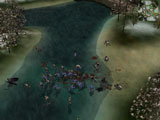 Myth III: The Wolf Age is a game
with a past. Myth II, its predecessor, was one of the games talked about in all the gaming
circles; it was hailed as a landmark in the genre of real time strategy/tactical combat.
It was a game to play. With rich graphics, no resource management, creative missions, and
dwarfs that throw body-tossing explosives – it is a game almost in a genre by itself.
The name behind Myth III, therefore, carries with it great expectations. It, unlike other
games, is not allowed to be mediocre. In order to be a good game, in order to meet our
expectations; it must be great.
Myth III: The Wolf Age is a game
with a past. Myth II, its predecessor, was one of the games talked about in all the gaming
circles; it was hailed as a landmark in the genre of real time strategy/tactical combat.
It was a game to play. With rich graphics, no resource management, creative missions, and
dwarfs that throw body-tossing explosives – it is a game almost in a genre by itself.
The name behind Myth III, therefore, carries with it great expectations. It, unlike other
games, is not allowed to be mediocre. In order to be a good game, in order to meet our
expectations; it must be great. 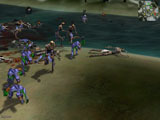 Considering that, it appears that
the Myth series is in capable hands. The latest Myth addition is filled with all the
elements, though in new ways, that made the original so fun (i.e. explosive throwing
dwarfs). The graphics are beautiful, the missions are compelling and engaging, and there
is a surprising depth to the game play and storyline. The Myth world is one that has been
rendered in painstaking detail, from the blades of grass at the feet of your units to the
torchbearers that light the way for your sword-wielding minions. The single player
missions, the explosions and the bad guys, they all come presented with just enough spice
to be really quite impressive, but not enough to suggest that it’s compensating for
something.
Considering that, it appears that
the Myth series is in capable hands. The latest Myth addition is filled with all the
elements, though in new ways, that made the original so fun (i.e. explosive throwing
dwarfs). The graphics are beautiful, the missions are compelling and engaging, and there
is a surprising depth to the game play and storyline. The Myth world is one that has been
rendered in painstaking detail, from the blades of grass at the feet of your units to the
torchbearers that light the way for your sword-wielding minions. The single player
missions, the explosions and the bad guys, they all come presented with just enough spice
to be really quite impressive, but not enough to suggest that it’s compensating for
something.
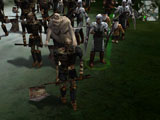 In
Myth III, you assume the indirect control of Connacht the Wolf, one of the Fallen Lords
that you battled against in Myth I-- only thousands of years before, when he was still a
good guy. The world is under assault, forced to surrender good lands and good men to the
hordes of Myrkridian (ugly, bat-like creatures) that are washing over the kingdoms of man.
As the only military leader to ever lead an army to victory against the Myrkridian, you
find yourself a hero, and mankind’s last hope. As a commanding officer, you directly
control on average between ten to twenty troops through varying forms of missions.
In
Myth III, you assume the indirect control of Connacht the Wolf, one of the Fallen Lords
that you battled against in Myth I-- only thousands of years before, when he was still a
good guy. The world is under assault, forced to surrender good lands and good men to the
hordes of Myrkridian (ugly, bat-like creatures) that are washing over the kingdoms of man.
As the only military leader to ever lead an army to victory against the Myrkridian, you
find yourself a hero, and mankind’s last hope. As a commanding officer, you directly
control on average between ten to twenty troops through varying forms of missions.
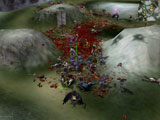 The
action of your units is controlled from an aerial camera that is fully dynamic, allowing
you to zoom in on and swivel around your units, examining them from any direction. In
fact, mastering the controls of your overhead camera is essential to playing the game,
since objects can sometimes obscure your view. Luckily, I found this to be a skill that
came quickly with practice, though it will take some getting used to for those who have
never experienced the Myth series before. The game play itself remains basically unchanged
from that of its predecessors.
The
action of your units is controlled from an aerial camera that is fully dynamic, allowing
you to zoom in on and swivel around your units, examining them from any direction. In
fact, mastering the controls of your overhead camera is essential to playing the game,
since objects can sometimes obscure your view. Luckily, I found this to be a skill that
came quickly with practice, though it will take some getting used to for those who have
never experienced the Myth series before. The game play itself remains basically unchanged
from that of its predecessors.
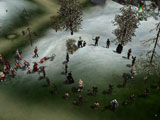 As
the game progresses, you gain a number of incredibly well designed troops. In one case,
the dwarves lay satchels that can be exploded like landmines, and entire missions are
dedicated to wiping out hordes of enemies with them. The introduction of these units is
seamlessly tie into the storyline. Dwarves do not assist in the war until you’ve
battled to save their homeland. Larger units do not appear until certain alliances are
made, following certain defeats. These missions, and the others that follow, are both
engaging and creative. They range from simple hack-and-slash, to puzzles based on
hack-and-slash (but in a good way). While the basic structure of the game remains
constant, with little variation in the style of play, I only found myself more and more
interested in the game the farther I progressed. No matter how many times I saw an enemy
blown to bits with a magical fireball, I always enjoyed it.
As
the game progresses, you gain a number of incredibly well designed troops. In one case,
the dwarves lay satchels that can be exploded like landmines, and entire missions are
dedicated to wiping out hordes of enemies with them. The introduction of these units is
seamlessly tie into the storyline. Dwarves do not assist in the war until you’ve
battled to save their homeland. Larger units do not appear until certain alliances are
made, following certain defeats. These missions, and the others that follow, are both
engaging and creative. They range from simple hack-and-slash, to puzzles based on
hack-and-slash (but in a good way). While the basic structure of the game remains
constant, with little variation in the style of play, I only found myself more and more
interested in the game the farther I progressed. No matter how many times I saw an enemy
blown to bits with a magical fireball, I always enjoyed it.
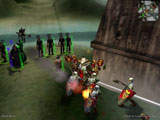 Graphically,
Myth III is a work of art. Regardless of where your troops are fighting, or what time of
day, the locations are always well realized and rendered with a touch of the beautiful.
The new three-dimensional graphics engine adopted by the design crew allows for monsters
that tower over your troops far better than they ever have in the past games. The swamps
are full of fog and muck, the trees are moist with fresh rain, and the deserts are filled
with jagged rocks. Without a doubt, the way that the trees bend from an explosion, folding
back from the shockwave, is one of the coolest visual effects I have ever seen in a
computer game. The level of detail is really quite impressive. Your units show off their
tattoos when you zoom in close enough, and there is something very satisfying about
watching the head of an undead monster launch into the sky after you hit him with a pipe
bomb.
Graphically,
Myth III is a work of art. Regardless of where your troops are fighting, or what time of
day, the locations are always well realized and rendered with a touch of the beautiful.
The new three-dimensional graphics engine adopted by the design crew allows for monsters
that tower over your troops far better than they ever have in the past games. The swamps
are full of fog and muck, the trees are moist with fresh rain, and the deserts are filled
with jagged rocks. Without a doubt, the way that the trees bend from an explosion, folding
back from the shockwave, is one of the coolest visual effects I have ever seen in a
computer game. The level of detail is really quite impressive. Your units show off their
tattoos when you zoom in close enough, and there is something very satisfying about
watching the head of an undead monster launch into the sky after you hit him with a pipe
bomb.
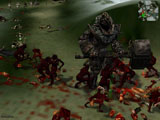 On the
surface, it would be easy to underestimate the depth of Myth III. The game play does not
seem to lend itself to complexity, yet it never ceased to surprise me with new and
innovative additions. For example, the wind can affect how accurate your archers are; at
night your men fight more efficiently when accompanied with torchbearers, and the shadows
cast by the fire tossed from your warlock’s hands is just plain cool. The gas bombs
roll down hills, the rain puts out fire arrows, and as I’ve mentioned, I don’t
believe that I have ever seen a cooler graphical effect than the way that the terrain
reacts to explosions.
On the
surface, it would be easy to underestimate the depth of Myth III. The game play does not
seem to lend itself to complexity, yet it never ceased to surprise me with new and
innovative additions. For example, the wind can affect how accurate your archers are; at
night your men fight more efficiently when accompanied with torchbearers, and the shadows
cast by the fire tossed from your warlock’s hands is just plain cool. The gas bombs
roll down hills, the rain puts out fire arrows, and as I’ve mentioned, I don’t
believe that I have ever seen a cooler graphical effect than the way that the terrain
reacts to explosions.
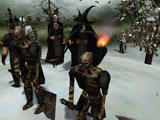 So
much work obviously went into the visual details that it is not too surprising that the
game’s flaws, of which there are a few, seem to show up in functionality. The
graphics depicting your unit’s health meters, for example, are such that I found it
almost impossible to easily discern how injured they were. Myth III has a tendency of
withholding vital information, and tends to instead assume that there are certain elements
of the game you are already familiar with. Each level has a number of hints associated
with it that can be accessed through a button in the upper right of the screen.
Unfortunately for those of us too macho to consult any button labeled such, the
information contained within is not merely useful, but vital. I spent nearly two hours
attacking and re-attacking an enemy base in the second level, fighting battle after
battle, only to find myself with almost no troops remaining by the time I arrived at the
enemy encampment. The archers couldn’t shoot through my swordsmen, and the two
village people were nearly useless in a fight and always died first—followed by my
soldiers soon after. It wasn’t until I consulted the "hints" that I
discovered that the two useless villagers were carrying torches that enabled my warriors
to see properly, and that if I kept them alive (I’d been sending them to the front of
the line before then), my troops would be able to kill something. I passed the level in
ten minutes.
So
much work obviously went into the visual details that it is not too surprising that the
game’s flaws, of which there are a few, seem to show up in functionality. The
graphics depicting your unit’s health meters, for example, are such that I found it
almost impossible to easily discern how injured they were. Myth III has a tendency of
withholding vital information, and tends to instead assume that there are certain elements
of the game you are already familiar with. Each level has a number of hints associated
with it that can be accessed through a button in the upper right of the screen.
Unfortunately for those of us too macho to consult any button labeled such, the
information contained within is not merely useful, but vital. I spent nearly two hours
attacking and re-attacking an enemy base in the second level, fighting battle after
battle, only to find myself with almost no troops remaining by the time I arrived at the
enemy encampment. The archers couldn’t shoot through my swordsmen, and the two
village people were nearly useless in a fight and always died first—followed by my
soldiers soon after. It wasn’t until I consulted the "hints" that I
discovered that the two useless villagers were carrying torches that enabled my warriors
to see properly, and that if I kept them alive (I’d been sending them to the front of
the line before then), my troops would be able to kill something. I passed the level in
ten minutes.
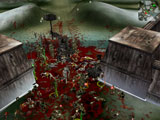 Another
time I wandered from one end of a map to another looking for the entrance to a cave, until
I read in the "hints" that access could only be gained by placing your units in
various points on the map. Without any obvious logic to explain why you had to stand
there, or even to suggest that you had to stand anywhere, the puzzle would have been very
difficult to figure out alone.
Another
time I wandered from one end of a map to another looking for the entrance to a cave, until
I read in the "hints" that access could only be gained by placing your units in
various points on the map. Without any obvious logic to explain why you had to stand
there, or even to suggest that you had to stand anywhere, the puzzle would have been very
difficult to figure out alone.
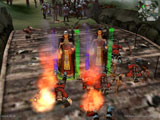 Since
the maps have no reference points, or clues to your destination, I found myself spending a
great deal of time merely trying to figure out which direction my target lay. Attacking a
city didn’t simply mean I had to devise a battle plan. First I had to find it.
Since
the maps have no reference points, or clues to your destination, I found myself spending a
great deal of time merely trying to figure out which direction my target lay. Attacking a
city didn’t simply mean I had to devise a battle plan. First I had to find it.
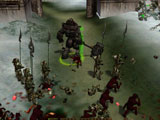 The
formation controls were less than useful. When ordering your archers into a line to
support your troops, you have no control over which direction the line of your formation
faces. This left you with a defensive group that often stood like a pencil with the eraser
pointed at the head of the enemy charge. Since the archers are unable to shoot around,
over, or through your own troops, it effectively disables all but your lead (and quickly
dead), archer.
The
formation controls were less than useful. When ordering your archers into a line to
support your troops, you have no control over which direction the line of your formation
faces. This left you with a defensive group that often stood like a pencil with the eraser
pointed at the head of the enemy charge. Since the archers are unable to shoot around,
over, or through your own troops, it effectively disables all but your lead (and quickly
dead), archer.
These flaws appear mainly in execution at the level of play. They appear at times to
make the game frustrating; they are annoying, but ultimately do not detract too much from
the game itself. Without these faults the game would be better, true, but with them it is
still very good. While the game engine hasn’t changed a great deal since Myth II (it
uses a modified version of the old one), there is little doubt that Myth III: The Wolf Age
still has all of the elements that were so addicting back then. If you enjoyed the
original, you’ll also love this. If you’re looking at the Myth series for the
first time, Myth III is an adequate representation of what the series has to offer.
It’s a good game with a strong basis. Without changing how the series plays very
significantly, the new Myth caretakers have aimed to pave the road already laid in gravel
by its predecessor, and done a good job of it. The game is solid.
